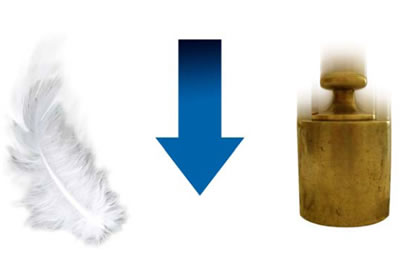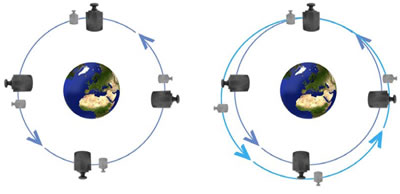Theoreticians and investigators in fundamental physics in space met for a conference at the Onera center in Palaiseau on Monday, September 19th. These specialists came to support the Microscope space mission and to emphasize how important it is for scientific knowledge. Microscope is a satellite (Cnes project) to confirm or invalidate the principle of equivalence, observed by Galileo, then by Newton, and which is the basis of the theory of general relativity of Einstein. The decision to launch Microscope in 2017 has been confirmed by the French space agency CNES in december 2011.
Thibault Damour mentioned the theoretical developments aiming to reconcile gravitation with Quantum Theory, suggesting that the principle of equivalence could be violated at a level smaller that the best level currently tested (10-12), but which could be accessible to the Microscope mission, which is one thousand times more accurate (10-15).
The investigators presented various approaches to testing the principle of equivalence (on the ground or in space), and the teams linked to the project gave an overview of the stages of the project and its scientific and technological maturity.
In conclusion, the guests at the round table emphasized that Microscope was, for the time being, the only project on the international level capable of advancing by three orders of magnitude our knowledge of the fundamental laws of physics.
More about Microscope
The professors Claude Cohen-Tannoudji (ENS Paris, 1997 Nobel prize), Thibault Damour (IHES Paris) and Claus Lämmerzahl (Zarm, Bremen) summarized the principle of equivalence, which postulates that a mass subject to inertia is identical to a mass subject to gravitation. This principle is equivalent to that of the universality of the falling of bodies stated by Galileo in 1602: “All bodies, feathers like lead, have the same law of fall.”
This postulate turns out to be the cornerstone of General Relativity, Einstein’s great theory of gravitation which has never been experimentally disproved. Its equations govern many of the phenomena observed in the Universe.
The stakes of the verification of this principle are enormous: if it were violated then that could mean that there exists a force that is unknown to us and this would open up the way to a new physics, a theory that is broader than general relativity.
The accuracy (10-15) of the Microscope’s ultra-sensitive accelerometers, designed and manufactured by Onera, is such that it would make possible the detection of the difference postulated by some theoreticians.
For many years now physicists have been looking for a quantum gravity, the Grail of fundamental physics, that would be a bridge between the macroscopic world of general relativity and the strange microscopic world of the quantum field theory, within the framework of a unified theory of physics such as string theory. This would be a real revolution, not just for physics but for our vision of the world.
In the event of confirmation of the principle of equivalence, this would significantly constrain current theoretical constructions because this principle would then have been verified some 1000 times more accurately than in the past.
Microscope offers a real potential for discovery for the most fundamental physics, complementary to, but just as crucial as, the large accelerators such at the LHC which is now being used to look for the Higgs boson, thought to be the origin of the mass of elementary particles.
Microscope is being conducted by the best theoreticians in fundamental space physics, associated with the best specialists in space metrology, who are at Onera. They have been working for more than twelve years now on this unique project which it is hoped will achieve a world scientific “first”, having an exceptional impact on our knowledge. Their know-how has been well demonstrated with the Champ, Grace and Goce missions and we now know that this project can be carried out with very limited instrument risk.
The scientific and technological challenge that the building of this large instrument and the orbital experiment represent have mobilized the enthusiasm and energy of the researchers of both Onera and CNES.
The Microscope mission, which should run for one year, is now ready to be launched. Scientists are impatient to begin the countdown to 2015

The Universality of falling bodies
Galileo: “All bodies, feathers like lead, have the same law of fall.” This postulate is part of Einstein’s principle of equivalence. If it is challenged, then general relativity will fall apart…

Principle of the Microscope mission
An orbital trajectory is an almost perpetual free fall because the mobile object is only subjected to gravitation.
The principle of Microscope is to compare the trajectories of two masses of different compositions located at the center of the satellite in orbit. If the ultra-sensitive accelerometer measures a minute deviation between the two trajectories (with an accuracy of up to one ten millionth of a billionth of earth’s gravity), this would mean a violation of the principle of equivalence. At present, only space can offer measurement conditions that are this accurate for mechanical experiments.
In orbit in the satellite: two test masses, one made of platinum (very dense), the other of titanium (a metal four times less dense than platinum). The least difference in their behaviors would throw the principle of equivalence into doubt.
If the trajectories of the masses are the same, then the gravitational mass equals the inertial mass and the principle of equivalence still holds.
If the accelerometers detect a deviation of the trajectories, then the gravitational mass differs from the inertial mass and the principle of equivalence is violated.




